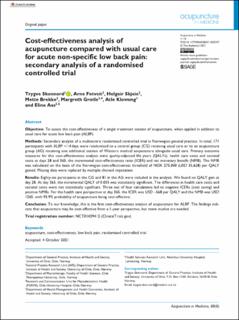| dc.contributor.author | Skonnord, Trygve | |
| dc.contributor.author | Fetveit, Arne | |
| dc.contributor.author | Skjeie, Holgeir | |
| dc.contributor.author | Brekke, Mette | |
| dc.contributor.author | Grotle, Margreth | |
| dc.contributor.author | Klovning, Atle | |
| dc.contributor.author | Aas, Eline | |
| dc.date.accessioned | 2022-08-11T11:29:40Z | |
| dc.date.available | 2022-08-11T11:29:40Z | |
| dc.date.created | 2021-12-01T08:37:49Z | |
| dc.date.issued | 2021 | |
| dc.identifier.issn | 0964-5284 | |
| dc.identifier.uri | https://hdl.handle.net/11250/3011273 | |
| dc.description.abstract | Objective: To assess the cost-effectiveness of a single treatment session of acupuncture, when applied in addition to usual care for acute low back pain (ALBP). Methods: Secondary analysis of a multicentre randomised controlled trial in Norwegian general practice. In total, 171 participants with ALBP ⩽14 days were randomised to a control group (CG) receiving usual care or to an acupuncture group (AG) receiving one additional session of Western medical acupuncture alongside usual care. Primary outcome measures for this cost-effectiveness analysis were quality-adjusted life years (QALYs), health care costs and societal costs at days 28 and 365, the incremental cost-effectiveness ratio (ICER) and net monetary benefit (NMB). The NMB was calculated on the basis of the Norwegian cost-effectiveness threshold of NOK 275,000 (USD 35,628) per QALY gained. Missing data were replaced by multiple chained imputation. Results: Eighty-six participants in the CG and 81 in the AG were included in the analysis. We found no QALY gain at day 28. At day 365, the incremental QALY of 0.035 was statistically significant. The differences in health care costs and societal costs were not statistically significant. Three out of four calculations led to negative ICERs (cost saving) and positive NMBs. For the health care perspective at day 365, the ICER was USD –568 per QALY and the NMB was USD 1265, with 95.9% probability of acupuncture being cost-effective. Conclusion: To our knowledge, this is the first cost-effectiveness analysis of acupuncture for ALBP. The findings indicate that acupuncture may be cost-effective from a 1-year perspective, but more studies are needed. Trial registration number: NCT01439412 (ClinicalTrials.gov). | en_US |
| dc.language.iso | eng | en_US |
| dc.publisher | SAGE Publications | en_US |
| dc.rights | Navngivelse 4.0 Internasjonal | * |
| dc.rights.uri | http://creativecommons.org/licenses/by/4.0/deed.no | * |
| dc.subject | Randomiserte kontrollerte studier | en_US |
| dc.subject | Randomized controlled studies | en_US |
| dc.subject | Akupunktur | en_US |
| dc.subject | Acupuncture | en_US |
| dc.subject | Allmennmedisin | en_US |
| dc.subject | General Practice | en_US |
| dc.subject | Kost-nytte analyse | en_US |
| dc.subject | Cost-benefit analysis | en_US |
| dc.title | Cost-effectiveness analysis of acupuncture compared with usual care for acute non-specific low back pain: Secondary analysis of a randomised controlled trial | en_US |
| dc.type | Peer reviewed | en_US |
| dc.type | Journal article | en_US |
| dc.description.version | publishedVersion | en_US |
| cristin.ispublished | false | |
| cristin.fulltext | original | |
| cristin.qualitycode | 1 | |
| dc.identifier.doi | 10.1177/09645284211055747 | |
| dc.identifier.cristin | 1962352 | |
| dc.source.journal | Acupuncture in Medicine | en_US |
| dc.subject.nsi | VDP::Allmennmedisin: 751 | en_US |
| dc.subject.nsi | VDP::General practice: 751 | en_US |

